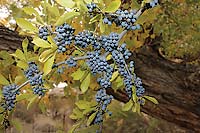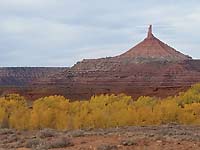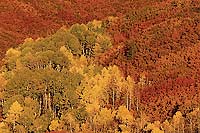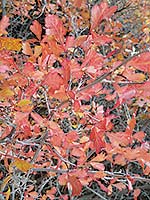 As if the colorful red rock landscape of southern Utah can’t get more spectacular, along comes autumn. Fall foliage colors punctuate the desert and blanket the mountains. Though some wildflowers may be involved in this color riot, often it is the leaves that create a mosaic of color across the landscape.
As if the colorful red rock landscape of southern Utah can’t get more spectacular, along comes autumn. Fall foliage colors punctuate the desert and blanket the mountains. Though some wildflowers may be involved in this color riot, often it is the leaves that create a mosaic of color across the landscape.
High up in the local La Sal and Abajo mountains, quaking aspen begin to shut down their photosynthetic pathways for the seasons in the fall. The trees are ready to shed their vibrant and verdant leaves as their chlorophyll pigments begin to break down and unmask other pigments overshadowed by the chlorophyll. These liberated pigments - carotenoids and anthocyanins - are responsible for the yellow, orange, and reddish leaf colors that mark the transition from fall to winter.
 The slogan “There’s gold in them thar hills,” may refer to the precious minerals, but also is applicable to the golden color of aspen leaves. Though a forest floor in a copse of aspen is often littered with the reminders of autumn, especially if a cold-snap muscles its way through the mountains and causes the trees to shed their leaves like New Year’s predictions, these leaves may hang tough on the trees throughout the fall season.
The slogan “There’s gold in them thar hills,” may refer to the precious minerals, but also is applicable to the golden color of aspen leaves. Though a forest floor in a copse of aspen is often littered with the reminders of autumn, especially if a cold-snap muscles its way through the mountains and causes the trees to shed their leaves like New Year’s predictions, these leaves may hang tough on the trees throughout the fall season.
Lower down on the peaks’ flanks, the mountain brush plant community, made up of Gambel’s oaks, mountain serviceberry, wild rose, single-leaf ash, and other shrubs, also continues to ignite the hillsides with flames of color. Individually, the shrubs may not be so spectacular, but as a collective, they create a patchwork patina of burnt sienna’s, russet golds, carmine, and sepia tones.
 Many of these shrubs also bear the fruit of their summer labors – berries, seeds or acorns that in turn attract mule deer, black bears, wild turkeys, Steller’s and western scrub-jays, as well as other wildlife species that cache and carry this abundant food source to consume later or devour in the moment.
Many of these shrubs also bear the fruit of their summer labors – berries, seeds or acorns that in turn attract mule deer, black bears, wild turkeys, Steller’s and western scrub-jays, as well as other wildlife species that cache and carry this abundant food source to consume later or devour in the moment.
Snaking down the mountains towards the desert below are ribbons of riparian vegetation such as coyote willow, Emory’s seep willow, Fremont’s cottonwood, and invasive tamarisk that line the waterways that course through the canyons. In autumn, these bands turn golden-yellow, a stark contrast to the red rock canyons that encase them.
 The drier uplands may also join in this Crayola procession as snakeweed, rubber rabbitbrush, purple asters, Wright’s bird beak, sunflowers, and the snowball corymbosum contribute floral coloration, instead of leaf color, to this transition. These later season bloomers attract butterflies, beetles and flies, and represent a sure-bet that summer is about to end.
The drier uplands may also join in this Crayola procession as snakeweed, rubber rabbitbrush, purple asters, Wright’s bird beak, sunflowers, and the snowball corymbosum contribute floral coloration, instead of leaf color, to this transition. These later season bloomers attract butterflies, beetles and flies, and represent a sure-bet that summer is about to end.
How long autumn lasts into the fall is always a matter of discussion. Prolonged warm temperatures and cool nights extends this “second summer” season some years into November. Other years, winter storms dip into the Southwest early and dust the high peaks with snow and cause the thermometer to drop below freezing. The cold temperatures accelerate the process of leaves littering the forest or valley floor. Though an early winter storm may cause the leaves to abscise that doesn’t mean winter is here to stay just yet.